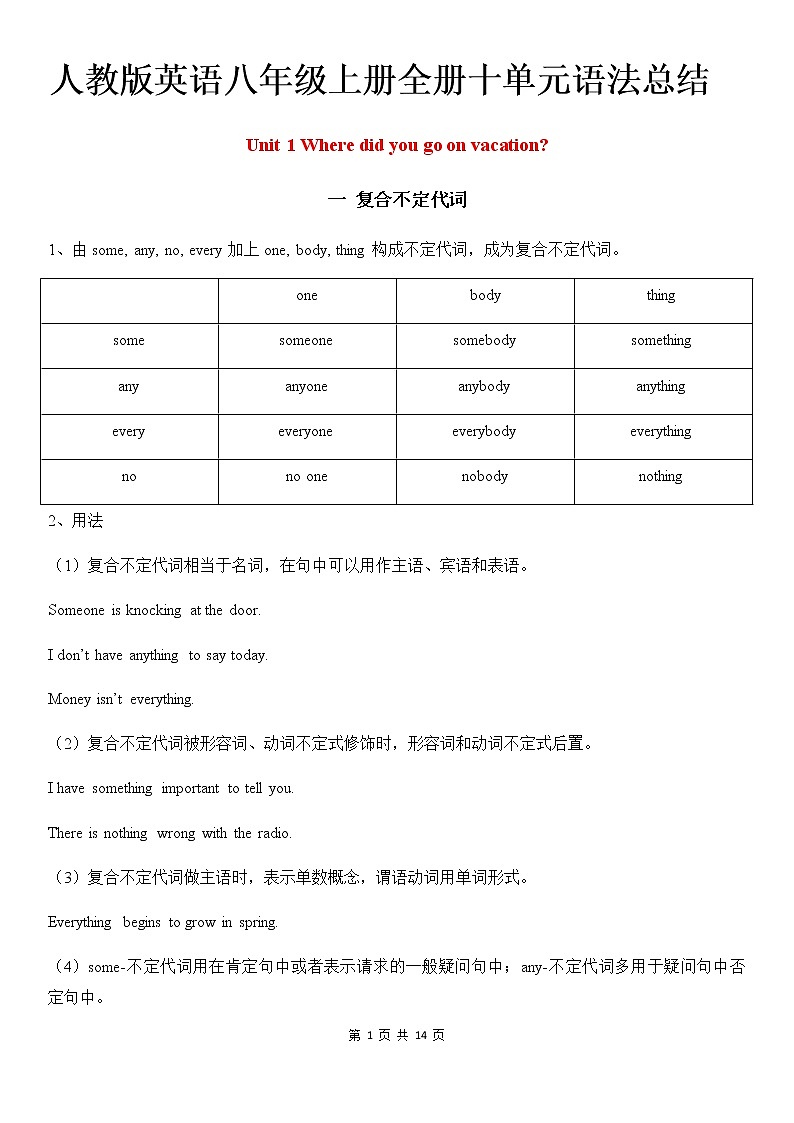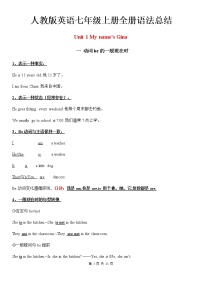


还剩11页未读,
继续阅读
人教版英语八年级上册全册十单元语法总结
展开
这是一份人教新目标 (Go for it) 版八年级上册本册综合优秀教案设计,共14页。教案主要包含了复合不定代词等内容,欢迎下载使用。
Unit 1 Where did yu g n vacatin?
一 复合不定代词
由sme, any, n, every加上ne, bdy, thing构成不定代词,成为复合不定代词。
用法
复合不定代词相当于名词,在句中可以用作主语、宾语和表语。
Smene is kncking at the dr.
I dn’t have anything t say tday.
Mney isn’t everything.
复合不定代词被形容词、动词不定式修饰时,形容词和动词不定式后置。
I have smething imprtant t tell yu.
There is nthing wrng with the radi.
复合不定代词做主语时,表示单数概念,谓语动词用单词形式。
Everything begins t grw in spring.
sme-不定代词用在肯定句中或者表示请求的一般疑问句中;any-不定代词多用于疑问句中否定句中。
Will yu ask smene t carry the bx fr me?
Wuld yu like smething t drink?
anyne和anything也可以用在肯定句中,表示“任何人”和“任何事”。
Anyne can d it.
I can d anything fr yu.
二 一般过去时的规则动词和不规则动词
(一)规则变化
构成规则:
在动词末尾直接加-ed . 例如,wrk -wrked , lk -lked , play –played
以不发音的字母e结尾的动词,直接加-d . 例如,live –lived , hpe –hped , use –used
以辅音字母+y结尾的,变y为i再加-ed . 例如,study –studied , carry –carried , wrry –wrried
以重读闭音节结尾且末尾只有一个辅音字母的,双写最后的辅音字母,再加-ed . 例如,stp –stpped , plan–planned
(二)不规则变化
1. 没有变化,即:与动词原形一样。例如,cut –cut , put –put , read –read
2. 变化元音,例如,write- wrte , knw –knew , cme –came
3. 变化辅音,例如,make –made , spend –spent , send –sent
4. 辅音和元音都变化,例如,leave –left , teach –taught , think –thught
5. 其他情况,例如,is –was , are –were , have –had
Unit 2 Hw ften d yu exercise?
频度副词
一、频度副词的含义
英语中常见的频度副词有usually, smetimes, always, ften, seldm, never等,它们用来表示动作发生的频率,但是在程度上有所区别,频率由高到低依次是:always>usually>ften>smetimes>seldm>never。频度副词放在be动词、情态动词和助动词之后,实义动词之前,对频率的提问用hw ften。
He’s always busy.
I never play a trick n thers.
Smetimes I g t schl by bus.
二、频度副词在句中的位置
频度副词一般放在实义动词之前,be动词、情态动词和助动词之后。
Lucy is smetimes busy.
I can hardly say a wrd.
They ften have cffee at night.
Unit 3 I'm mre utging than my sister
形容词和副词的比较级
= 1 \* GB3 \* MERGEFORMAT ① 形容词比较级的变化规则。
= 1 \* ROMAN \* MERGEFORMAT I. 规则变化
= 2 \* ROMAN \* MERGEFORMAT II. 不规则变化
= 2 \* GB3 \* MERGEFORMAT ② 形容词比较级用法。
= 1 \* ROMAN \* MERGEFORMAT I. 比较级用于两者进行比较,结构为“A is 比较级 than B”。
e.g: 1. My bike is mre beautiful than hers.我的自行车比她的漂亮。
2. He wrks harder than befre. 他工作比以前努力。
= 2 \* ROMAN \* MERGEFORMAT II. 表示两者之间选择,用“which/wh is 比较级,A r B?”表示“两者之间较……之一”时,用“the + 比较级”结构。
e.g: 1. Which is nearer t the sun, the mn r the earth? 哪个离太阳更近,月球还是地球?
2. He is the thinner f the tw. 他是两人中较瘦的那个。
= 3 \* ROMAN \* MERGEFORMAT III.“越来越……”用“比较级and 比较级”结构,多音节和部分双音节词用“mre and mre 原级”。
e.g: 1. The weather is becming clder and clder. 天气变得越来越冷了。
2. She is becming mre and mre beautiful. 她变得越来越美了。
= 4 \* ROMAN \* MERGEFORMAT IV. 表示“越……越……”时,用“the+比较级,the+比较级”结构。
e.g: The mre careful yu are, the mre pints yu will get. 你越细心,得分越多。
Unit 4 What's the best mvie theater?
形容词和副词最高级
变化规则
= 1 \* ROMAN \* MERGEFORMAT I. 规则变化
= 2 \* ROMAN \* MERGEFORMAT II. 不规则变化
二、用法
= 1 \* ROMAN \* MERGEFORMAT I. 表示三者及以上人或物进行比较时用最高级,结构为“the + 最高级+in/f + 范围”。
e.g: 1. The picture is the best f all. 这幅画是所有画中最好的。
2. She is the mst beautiful girl in the class. 她是班上最美的女孩。
= 2 \* ROMAN \* MERGEFORMAT II. 表示在三者及以上之间选择,用“which/wh is the+最高级,A, B r C?”。
e.g: Wh is the tallest, Tm, Kate r Bill? 汤姆、凯特、比尔,谁最高?
= 3 \* ROMAN \* MERGEFORMAT III. 表示“最……之一”用“ne f the最高级+可数名词复数”。
e.g: She is ne f the mst ppular teachers in ur schl. 她是我们学校最受欢迎的老师之一。
= 4 \* ROMAN \* MERGEFORMAT IV. 形容词最高级前面加序数词,表示“第几……”。
e.g: She is the secnd tallest girl in ur class. 她是我班上第二高的女孩。
= 5 \* ROMAN \* MERGEFORMAT V. 比较级和最高级之间的互换。
例如:
He is taller than any ther by in ur class.
= He is taller than the ther bys in ur class.
= He is the tallest by in ur class.
注意比较以下两个句子:
Shanghai is larger than any ther city in China.(范围之内)
= Shanghai is larger than any city in Japan.(范围之外)
Unit 5 D yu want t watch a game shw?
动词不定式作宾语
= 1 \* GB3 \* MERGEFORMAT ① 常见的能带动词不定式作宾语的动词有:want,like,lve,wish,hpe,need,try,ask,seem,help,learn,decide,plan,start,begin,frget,remember,chse ,prepare,agree等。
Kate wants t be a dctr when she grws up.
He decided t buy a new MP4.
We all hpe t g t Taizhu next mnth.
I dn’t like t be late fr schl.
I frgt t bring the MP4 hem.
= 2 \* GB3 \* MERGEFORMAT ② 有些动词后面接复合宾语时,常用it作形式宾语,而真正的宾语则由动词不定式来担当,并位于宾语补足语之后。常见的这样的动词有find,think,feel,make等。
I find it interesting t play cmputer games我发现玩电脑游戏很有趣。
We all think it very difficult t finish the wrk in an hur.
= 3 \* GB3 \* MERGEFORMAT ③ “疑问词+不定式”结构
疑问词wh,what,which,when,where和hw后接动词不定式可在句中作宾语、主语、表语。
I dn’t knw What t d next.
Can yu tell me hw t get t the hspital?
Unit 6 I'm ging t study cmputer science.
一般将来时
定义:一般将来时表示将来某个时间要发生的动作,事情或存在的状态,也表示将来经常或反复发生的动作或事情。
1.will/shall+动词原形 shall用于第一人称,常被will 所代替。will 在陈述句中用于各种人称,在征求意见时常用于第二人称。will nt=wn't shall nt=shan't例如:
e.g. Which paragraph shall I read first? 我先读哪一段呢?
Will yu be at hme at seven this evening? 今晚七点回家好吗?
2. be ging t +不定式,表示将来。
a. 主语的意图,即将做某事。
e.g. What are yu ging t d tmrrw? 明天打算做什么呢?
b. 计划,安排要发生的事。
e.g. The play is ging t be prduced next mnth。这出戏下月开播。
c. 有迹象要发生的事。
e.g. Lk at the dark cluds, there is ging t be a strm.
看那乌云,快要下暴雨了。
3. 现在进行时表将来时
下列位移动词的现在进行时表示将来时
g、cm、fly、leave、start、begin、finish、end、arrive…
e.g. she is leaving fr Wuhan tmrrw.明天她要动身去往武汉了。
Unit 7 Will peple have rbts?
一般将来时
定义:一般将来时表示将来某个时间要发生的动作,事情或存在的状态,也表示将来经常或反复发生的动作或事情。
1.will/shall+动词原形 shall用于第一人称,常被will 所代替。will 在陈述句中用于各种人称,在征求意见时常用于第二人称。will nt=wn't shall nt=shan't例如:
e.g. Which paragraph shall I read first? 我先读哪一段呢?
Will yu be at hme at seven this evening? 今晚七点回家好吗?
2. be ging t +不定式,表示将来。
a. 主语的意图,即将做某事。
e.g. What are yu ging t d tmrrw? 明天打算做什么呢?
b. 计划,安排要发生的事。
e.g. The play is ging t be prduced next mnth。这出戏下月开播。
c. 有迹象要发生的事。
e.g. Lk at the dark cluds, there is ging t be a strm.
看那乌云,快要下暴雨了。
3. 现在进行时表将来时
下列位移动词的现在进行时表示将来时
g、cm、fly、leave、start、begin、finish、end、arrive…
e.g. she is leaving fr Wuhan tmrrw.明天她要动身去往武汉了。
句型转换
1. “be ging t+动词原形”结构的一般疑问句是将be的相应形式前移到句首,即“Are/Is/Am+主语+ging t+动词原形+其它?”。其否定句是在be动词的相应形式后加nt.
如:他们打算今天下午踢足球。
(1)They are ging t play ftball this afternn.(肯定句)
(2)Are they ging t play ftball this afternn?(一般疑问句)
(3)They are nt ging t play ftball this afternn. (否定句)
2. “shall/will+动词原形”结构的一般疑问句是将shall或will前移到句首,即“Shall/Will+主语+动词原形+其它?”。其否定句是在shall或will后加nt.如:我们老师很快回来。
(1)Our teacher will cme back very sn. (肯定句)
(2)Will ur teacher cme back very sn?(一般疑问句)
(3)Our teacher wn’t cme back very sn. (否定句)
Unit 8 Hw d yu make a banana shake?
一 祈使句
1 祈使句定义
用于表达命令、请求、劝告、警告、禁止等的句子叫做祈使句。祈使句的动词都为一般现在时,句末则使用句号或感叹号。
2 祈使句结构
(1)第二人称祈使句通常用来向听话者发出命令,提出要求或建议。这种祈使句的主语yu 通常不表示出来,而是以动词原形开头。
(2)第一、三人称祈使句是以第一人称、第三人称代词或者名词等作为祈使的对象,这类祈使句通常以let为引导词表建议。
3 祈使句的强调形式及否定形式
(1)祈使句的强调形式是在整个结构之前加d。
(2)祈使句的否定形式是在整个结构之前加dn’t 或never。
(3)以let为引导词的祈使句的否定形式通常是在Let’s 或Let us/ me后加nt。
4祈使句的反意疑问句
(1)Let’s 表示第一人称的祈使句,反意疑问部分为“shall we”。
(2)Let me和Let us 表示第二人称的祈使句,反意疑问部分为“will yu”。
(3)其他行为动词引起的祈使句,无论其陈述部分是否定还是肯定的,多用“will。
二 可数名词和不可数名词
普通名词分为可数名词和不可数名词两类。
表示可以计算数目的人或物称为可数名词,可数名词单数前面可以用不定冠词a/an来修饰。
1.名词复数的规则变化:
(1)在词尾后加-s。如:bk→bks,cup→cups
(2)以s,x,sh,ch结尾的词后加一es。如:bus→buses,bx→bxes,dish→dishes。
watch→watches。
(3)以f,fe结尾的词,先将f或fe变成v再加-es。如:half→halves,wife→wives.
(4)以结尾表示有生命的事物的词后加-es。如:her→heres,ptat→ptates。
tmat→tmates,mang→manges。
(5)以辅音字母加y结尾的词,先将y改为i再加-es;以元音字母加y结尾的词,直接在词尾加-s。如:city→cities,family→families,by→bys,day→days。
2.名词复数的不规则变化:
(1)元音发生变化。如:
man→men,wman→wmen,ft→feet.tth→teeth,muse→mice,gse→geese
(2)单复数同形。如:
a sheep→tw sheep两只羊,a deer→five deer五只鹿,a fish→a lt f fish许多鱼,a
Chinese→sme Chinese一些中国人,a Japanese→three Japanese三个日本人
(3)有些名词只有复数形式。如:
clthes衣服,trusers裤子,glasses眼镜,scissrs剪刀,cmpasses圆规
(4)合成名词变为复数时,两个词都要变为复数。如:
tw men dctrs两名男医生,10 wmen teachers 10名女教师
3.不可数名词
不可数名词表示不能计算数目的人或物。它们前面不能用不定冠词a/an修饰,没有复数形式。不可数名词要表示数量,要借助于量词。如:
a cup f cffee 一杯咖啡,three pieces f bread 三片面包
Unit 9 Can yu cme t my party?
情态动词can的用法
情态动词是表示说话人的语气或情态,本身有词义但不能单独作谓语的词。常用的情态动词有can,may,must,culd,shall,will,need等。
情态动词在句中必须后跟动词原形,并与后面的动词一起构成谓语。情态动词没有人称和数的变化。
情态动词can的用法:
表示能力,意为“能,会”。
例如:Millie can play the pian.
表示许可,意为“可以”。
例如:Yu can use my pen. Can yu pass me the bks?
表示推测,意为“可能,会”,主要用于否定句和疑问句中。
例如:Can he be here?
He can’t have finished his hmewrk.
情态动词culd的用法:
culd是can的过去式,表示过去的能力,意为“能,会”。
例如:Culd yu speak English at the age f six?
His mther is a gd ck nw, but she culdn’t ck meals three years ag.
在某些场合,culd可用来代替can,表示现在的情况,culd比can语气更委婉。若用culd来提问问题,回答时,应该用can,而不用culd。
例如:--Culd yu answer me a questin?
--Yes, I can./N, I can’t.
情态动词may的用法:
表示许可,意为“许可”。
例如:May I cme in?
Yu may take everything yu like.
表示推测,通常用于肯定句和否定句中,意为“可能”。
例如:He may be very busy nw.
He said that she might nt be at wrk tday.
注意:can和may都不是可能性,can通常用于否定句和疑问句中,而may通常用于肯定句和否定句中。虽然两者均可用于否定句中,但其意思不同:can't意为“不可能”,may nt意为“可能不”。另外,can和may均可表示请求允许,但can为一般用词,而may为正式用词。
例如:It can’t be true.那不可能是真的。
It may nt be true.那可能不是真的。
Unit 10 If yu g t the party, yu will have a great time!
一 if引导条件状语从句
if/unless引导条件状语从句
if引导条件状语从句,如果主句为一般将来时、主句为祈使句或者含有情态动词时,if引导的条件状语从句用一般现在时表示将来。
例如:
We will g fishing if it desn't rain tmrrw.
Yu can g hme if yu finish yur hmewrk.
2. unless引导条件状语从句,表示“除非、如果不”,相当于if nt。如果主句为一般将来时、主句为祈使句或者含有情态动词时,unless引导的条件状语从句用一般现在时表示将来。
例如:
Unless yur wrk hard, yu wn't get gd grades.
Yu will miss the early bus unless yu hurry up.
二 shuld的用法
(1)表示“应该,应当”。
(2)表示“可能,该(=will prbably)”
(3)表示粗暴地拒绝一项建议、要求或指示。
He shuld wrk harder.
Passengers shuld prceed t Gate.
His backpack shuld be in the classrm.ne
bdy
thing
sme
smene
smebdy
smething
any
anyne
anybdy
anything
every
everyne
everybdy
everything
n
n ne
nbdy
nthing
构成法
原级
比较级
最高级
单音节词+er/est
shrt
shrter
shrtest
cld
clder
cldest
以不发音e结尾的词+r/st
wide
wider
widest
large
larger
largest
单个辅音字母结尾的重读闭音节词,双写末尾辅音字母+er/est
big
bigger
biggest
ht
htter
httest
以辅音字母+y结尾的词,变y为i+er/est
heavy
heavier
heaviest
busy
busier
busiest
多音节词在前面+mre/mst
imprtant
mre imprtant
mst imprtant
beautiful
mre beautiful
mst beautiful
原级
比较级
最高级
gd/well
better
best
bad/badly/ill
wrse
wrst
ld
lder/elder
ldest/eldest
many/much
mre
mst
little
less
least
far
farther/further
farthest/furthest
构成法
原级
最高级
单音节词+est
shrt
shrtest
cld
cldest
以不发音e结尾的词+st
wide
widest
large
largest
单个辅音字母结尾的重读闭音节词,双写末尾辅音字母+est
big
biggest
ht
httest
以辅音字母+y结尾的词,变y为i+est
heavy
heaviest
busy
busiest
多音节词在前面+mst
imprtant
mst imprtant
beautiful
mst beautiful
原级
最高级
gd/well
best
bad/badly/ill
wrst
ld
ldest/eldest
many/much
mst
little
least
far
farthest/furthest
Unit 1 Where did yu g n vacatin?
一 复合不定代词
由sme, any, n, every加上ne, bdy, thing构成不定代词,成为复合不定代词。
用法
复合不定代词相当于名词,在句中可以用作主语、宾语和表语。
Smene is kncking at the dr.
I dn’t have anything t say tday.
Mney isn’t everything.
复合不定代词被形容词、动词不定式修饰时,形容词和动词不定式后置。
I have smething imprtant t tell yu.
There is nthing wrng with the radi.
复合不定代词做主语时,表示单数概念,谓语动词用单词形式。
Everything begins t grw in spring.
sme-不定代词用在肯定句中或者表示请求的一般疑问句中;any-不定代词多用于疑问句中否定句中。
Will yu ask smene t carry the bx fr me?
Wuld yu like smething t drink?
anyne和anything也可以用在肯定句中,表示“任何人”和“任何事”。
Anyne can d it.
I can d anything fr yu.
二 一般过去时的规则动词和不规则动词
(一)规则变化
构成规则:
在动词末尾直接加-ed . 例如,wrk -wrked , lk -lked , play –played
以不发音的字母e结尾的动词,直接加-d . 例如,live –lived , hpe –hped , use –used
以辅音字母+y结尾的,变y为i再加-ed . 例如,study –studied , carry –carried , wrry –wrried
以重读闭音节结尾且末尾只有一个辅音字母的,双写最后的辅音字母,再加-ed . 例如,stp –stpped , plan–planned
(二)不规则变化
1. 没有变化,即:与动词原形一样。例如,cut –cut , put –put , read –read
2. 变化元音,例如,write- wrte , knw –knew , cme –came
3. 变化辅音,例如,make –made , spend –spent , send –sent
4. 辅音和元音都变化,例如,leave –left , teach –taught , think –thught
5. 其他情况,例如,is –was , are –were , have –had
Unit 2 Hw ften d yu exercise?
频度副词
一、频度副词的含义
英语中常见的频度副词有usually, smetimes, always, ften, seldm, never等,它们用来表示动作发生的频率,但是在程度上有所区别,频率由高到低依次是:always>usually>ften>smetimes>seldm>never。频度副词放在be动词、情态动词和助动词之后,实义动词之前,对频率的提问用hw ften。
He’s always busy.
I never play a trick n thers.
Smetimes I g t schl by bus.
二、频度副词在句中的位置
频度副词一般放在实义动词之前,be动词、情态动词和助动词之后。
Lucy is smetimes busy.
I can hardly say a wrd.
They ften have cffee at night.
Unit 3 I'm mre utging than my sister
形容词和副词的比较级
= 1 \* GB3 \* MERGEFORMAT ① 形容词比较级的变化规则。
= 1 \* ROMAN \* MERGEFORMAT I. 规则变化
= 2 \* ROMAN \* MERGEFORMAT II. 不规则变化
= 2 \* GB3 \* MERGEFORMAT ② 形容词比较级用法。
= 1 \* ROMAN \* MERGEFORMAT I. 比较级用于两者进行比较,结构为“A is 比较级 than B”。
e.g: 1. My bike is mre beautiful than hers.我的自行车比她的漂亮。
2. He wrks harder than befre. 他工作比以前努力。
= 2 \* ROMAN \* MERGEFORMAT II. 表示两者之间选择,用“which/wh is 比较级,A r B?”表示“两者之间较……之一”时,用“the + 比较级”结构。
e.g: 1. Which is nearer t the sun, the mn r the earth? 哪个离太阳更近,月球还是地球?
2. He is the thinner f the tw. 他是两人中较瘦的那个。
= 3 \* ROMAN \* MERGEFORMAT III.“越来越……”用“比较级and 比较级”结构,多音节和部分双音节词用“mre and mre 原级”。
e.g: 1. The weather is becming clder and clder. 天气变得越来越冷了。
2. She is becming mre and mre beautiful. 她变得越来越美了。
= 4 \* ROMAN \* MERGEFORMAT IV. 表示“越……越……”时,用“the+比较级,the+比较级”结构。
e.g: The mre careful yu are, the mre pints yu will get. 你越细心,得分越多。
Unit 4 What's the best mvie theater?
形容词和副词最高级
变化规则
= 1 \* ROMAN \* MERGEFORMAT I. 规则变化
= 2 \* ROMAN \* MERGEFORMAT II. 不规则变化
二、用法
= 1 \* ROMAN \* MERGEFORMAT I. 表示三者及以上人或物进行比较时用最高级,结构为“the + 最高级+in/f + 范围”。
e.g: 1. The picture is the best f all. 这幅画是所有画中最好的。
2. She is the mst beautiful girl in the class. 她是班上最美的女孩。
= 2 \* ROMAN \* MERGEFORMAT II. 表示在三者及以上之间选择,用“which/wh is the+最高级,A, B r C?”。
e.g: Wh is the tallest, Tm, Kate r Bill? 汤姆、凯特、比尔,谁最高?
= 3 \* ROMAN \* MERGEFORMAT III. 表示“最……之一”用“ne f the最高级+可数名词复数”。
e.g: She is ne f the mst ppular teachers in ur schl. 她是我们学校最受欢迎的老师之一。
= 4 \* ROMAN \* MERGEFORMAT IV. 形容词最高级前面加序数词,表示“第几……”。
e.g: She is the secnd tallest girl in ur class. 她是我班上第二高的女孩。
= 5 \* ROMAN \* MERGEFORMAT V. 比较级和最高级之间的互换。
例如:
He is taller than any ther by in ur class.
= He is taller than the ther bys in ur class.
= He is the tallest by in ur class.
注意比较以下两个句子:
Shanghai is larger than any ther city in China.(范围之内)
= Shanghai is larger than any city in Japan.(范围之外)
Unit 5 D yu want t watch a game shw?
动词不定式作宾语
= 1 \* GB3 \* MERGEFORMAT ① 常见的能带动词不定式作宾语的动词有:want,like,lve,wish,hpe,need,try,ask,seem,help,learn,decide,plan,start,begin,frget,remember,chse ,prepare,agree等。
Kate wants t be a dctr when she grws up.
He decided t buy a new MP4.
We all hpe t g t Taizhu next mnth.
I dn’t like t be late fr schl.
I frgt t bring the MP4 hem.
= 2 \* GB3 \* MERGEFORMAT ② 有些动词后面接复合宾语时,常用it作形式宾语,而真正的宾语则由动词不定式来担当,并位于宾语补足语之后。常见的这样的动词有find,think,feel,make等。
I find it interesting t play cmputer games我发现玩电脑游戏很有趣。
We all think it very difficult t finish the wrk in an hur.
= 3 \* GB3 \* MERGEFORMAT ③ “疑问词+不定式”结构
疑问词wh,what,which,when,where和hw后接动词不定式可在句中作宾语、主语、表语。
I dn’t knw What t d next.
Can yu tell me hw t get t the hspital?
Unit 6 I'm ging t study cmputer science.
一般将来时
定义:一般将来时表示将来某个时间要发生的动作,事情或存在的状态,也表示将来经常或反复发生的动作或事情。
1.will/shall+动词原形 shall用于第一人称,常被will 所代替。will 在陈述句中用于各种人称,在征求意见时常用于第二人称。will nt=wn't shall nt=shan't例如:
e.g. Which paragraph shall I read first? 我先读哪一段呢?
Will yu be at hme at seven this evening? 今晚七点回家好吗?
2. be ging t +不定式,表示将来。
a. 主语的意图,即将做某事。
e.g. What are yu ging t d tmrrw? 明天打算做什么呢?
b. 计划,安排要发生的事。
e.g. The play is ging t be prduced next mnth。这出戏下月开播。
c. 有迹象要发生的事。
e.g. Lk at the dark cluds, there is ging t be a strm.
看那乌云,快要下暴雨了。
3. 现在进行时表将来时
下列位移动词的现在进行时表示将来时
g、cm、fly、leave、start、begin、finish、end、arrive…
e.g. she is leaving fr Wuhan tmrrw.明天她要动身去往武汉了。
Unit 7 Will peple have rbts?
一般将来时
定义:一般将来时表示将来某个时间要发生的动作,事情或存在的状态,也表示将来经常或反复发生的动作或事情。
1.will/shall+动词原形 shall用于第一人称,常被will 所代替。will 在陈述句中用于各种人称,在征求意见时常用于第二人称。will nt=wn't shall nt=shan't例如:
e.g. Which paragraph shall I read first? 我先读哪一段呢?
Will yu be at hme at seven this evening? 今晚七点回家好吗?
2. be ging t +不定式,表示将来。
a. 主语的意图,即将做某事。
e.g. What are yu ging t d tmrrw? 明天打算做什么呢?
b. 计划,安排要发生的事。
e.g. The play is ging t be prduced next mnth。这出戏下月开播。
c. 有迹象要发生的事。
e.g. Lk at the dark cluds, there is ging t be a strm.
看那乌云,快要下暴雨了。
3. 现在进行时表将来时
下列位移动词的现在进行时表示将来时
g、cm、fly、leave、start、begin、finish、end、arrive…
e.g. she is leaving fr Wuhan tmrrw.明天她要动身去往武汉了。
句型转换
1. “be ging t+动词原形”结构的一般疑问句是将be的相应形式前移到句首,即“Are/Is/Am+主语+ging t+动词原形+其它?”。其否定句是在be动词的相应形式后加nt.
如:他们打算今天下午踢足球。
(1)They are ging t play ftball this afternn.(肯定句)
(2)Are they ging t play ftball this afternn?(一般疑问句)
(3)They are nt ging t play ftball this afternn. (否定句)
2. “shall/will+动词原形”结构的一般疑问句是将shall或will前移到句首,即“Shall/Will+主语+动词原形+其它?”。其否定句是在shall或will后加nt.如:我们老师很快回来。
(1)Our teacher will cme back very sn. (肯定句)
(2)Will ur teacher cme back very sn?(一般疑问句)
(3)Our teacher wn’t cme back very sn. (否定句)
Unit 8 Hw d yu make a banana shake?
一 祈使句
1 祈使句定义
用于表达命令、请求、劝告、警告、禁止等的句子叫做祈使句。祈使句的动词都为一般现在时,句末则使用句号或感叹号。
2 祈使句结构
(1)第二人称祈使句通常用来向听话者发出命令,提出要求或建议。这种祈使句的主语yu 通常不表示出来,而是以动词原形开头。
(2)第一、三人称祈使句是以第一人称、第三人称代词或者名词等作为祈使的对象,这类祈使句通常以let为引导词表建议。
3 祈使句的强调形式及否定形式
(1)祈使句的强调形式是在整个结构之前加d。
(2)祈使句的否定形式是在整个结构之前加dn’t 或never。
(3)以let为引导词的祈使句的否定形式通常是在Let’s 或Let us/ me后加nt。
4祈使句的反意疑问句
(1)Let’s 表示第一人称的祈使句,反意疑问部分为“shall we”。
(2)Let me和Let us 表示第二人称的祈使句,反意疑问部分为“will yu”。
(3)其他行为动词引起的祈使句,无论其陈述部分是否定还是肯定的,多用“will。
二 可数名词和不可数名词
普通名词分为可数名词和不可数名词两类。
表示可以计算数目的人或物称为可数名词,可数名词单数前面可以用不定冠词a/an来修饰。
1.名词复数的规则变化:
(1)在词尾后加-s。如:bk→bks,cup→cups
(2)以s,x,sh,ch结尾的词后加一es。如:bus→buses,bx→bxes,dish→dishes。
watch→watches。
(3)以f,fe结尾的词,先将f或fe变成v再加-es。如:half→halves,wife→wives.
(4)以结尾表示有生命的事物的词后加-es。如:her→heres,ptat→ptates。
tmat→tmates,mang→manges。
(5)以辅音字母加y结尾的词,先将y改为i再加-es;以元音字母加y结尾的词,直接在词尾加-s。如:city→cities,family→families,by→bys,day→days。
2.名词复数的不规则变化:
(1)元音发生变化。如:
man→men,wman→wmen,ft→feet.tth→teeth,muse→mice,gse→geese
(2)单复数同形。如:
a sheep→tw sheep两只羊,a deer→five deer五只鹿,a fish→a lt f fish许多鱼,a
Chinese→sme Chinese一些中国人,a Japanese→three Japanese三个日本人
(3)有些名词只有复数形式。如:
clthes衣服,trusers裤子,glasses眼镜,scissrs剪刀,cmpasses圆规
(4)合成名词变为复数时,两个词都要变为复数。如:
tw men dctrs两名男医生,10 wmen teachers 10名女教师
3.不可数名词
不可数名词表示不能计算数目的人或物。它们前面不能用不定冠词a/an修饰,没有复数形式。不可数名词要表示数量,要借助于量词。如:
a cup f cffee 一杯咖啡,three pieces f bread 三片面包
Unit 9 Can yu cme t my party?
情态动词can的用法
情态动词是表示说话人的语气或情态,本身有词义但不能单独作谓语的词。常用的情态动词有can,may,must,culd,shall,will,need等。
情态动词在句中必须后跟动词原形,并与后面的动词一起构成谓语。情态动词没有人称和数的变化。
情态动词can的用法:
表示能力,意为“能,会”。
例如:Millie can play the pian.
表示许可,意为“可以”。
例如:Yu can use my pen. Can yu pass me the bks?
表示推测,意为“可能,会”,主要用于否定句和疑问句中。
例如:Can he be here?
He can’t have finished his hmewrk.
情态动词culd的用法:
culd是can的过去式,表示过去的能力,意为“能,会”。
例如:Culd yu speak English at the age f six?
His mther is a gd ck nw, but she culdn’t ck meals three years ag.
在某些场合,culd可用来代替can,表示现在的情况,culd比can语气更委婉。若用culd来提问问题,回答时,应该用can,而不用culd。
例如:--Culd yu answer me a questin?
--Yes, I can./N, I can’t.
情态动词may的用法:
表示许可,意为“许可”。
例如:May I cme in?
Yu may take everything yu like.
表示推测,通常用于肯定句和否定句中,意为“可能”。
例如:He may be very busy nw.
He said that she might nt be at wrk tday.
注意:can和may都不是可能性,can通常用于否定句和疑问句中,而may通常用于肯定句和否定句中。虽然两者均可用于否定句中,但其意思不同:can't意为“不可能”,may nt意为“可能不”。另外,can和may均可表示请求允许,但can为一般用词,而may为正式用词。
例如:It can’t be true.那不可能是真的。
It may nt be true.那可能不是真的。
Unit 10 If yu g t the party, yu will have a great time!
一 if引导条件状语从句
if/unless引导条件状语从句
if引导条件状语从句,如果主句为一般将来时、主句为祈使句或者含有情态动词时,if引导的条件状语从句用一般现在时表示将来。
例如:
We will g fishing if it desn't rain tmrrw.
Yu can g hme if yu finish yur hmewrk.
2. unless引导条件状语从句,表示“除非、如果不”,相当于if nt。如果主句为一般将来时、主句为祈使句或者含有情态动词时,unless引导的条件状语从句用一般现在时表示将来。
例如:
Unless yur wrk hard, yu wn't get gd grades.
Yu will miss the early bus unless yu hurry up.
二 shuld的用法
(1)表示“应该,应当”。
(2)表示“可能,该(=will prbably)”
(3)表示粗暴地拒绝一项建议、要求或指示。
He shuld wrk harder.
Passengers shuld prceed t Gate.
His backpack shuld be in the classrm.ne
bdy
thing
sme
smene
smebdy
smething
any
anyne
anybdy
anything
every
everyne
everybdy
everything
n
n ne
nbdy
nthing
构成法
原级
比较级
最高级
单音节词+er/est
shrt
shrter
shrtest
cld
clder
cldest
以不发音e结尾的词+r/st
wide
wider
widest
large
larger
largest
单个辅音字母结尾的重读闭音节词,双写末尾辅音字母+er/est
big
bigger
biggest
ht
htter
httest
以辅音字母+y结尾的词,变y为i+er/est
heavy
heavier
heaviest
busy
busier
busiest
多音节词在前面+mre/mst
imprtant
mre imprtant
mst imprtant
beautiful
mre beautiful
mst beautiful
原级
比较级
最高级
gd/well
better
best
bad/badly/ill
wrse
wrst
ld
lder/elder
ldest/eldest
many/much
mre
mst
little
less
least
far
farther/further
farthest/furthest
构成法
原级
最高级
单音节词+est
shrt
shrtest
cld
cldest
以不发音e结尾的词+st
wide
widest
large
largest
单个辅音字母结尾的重读闭音节词,双写末尾辅音字母+est
big
biggest
ht
httest
以辅音字母+y结尾的词,变y为i+est
heavy
heaviest
busy
busiest
多音节词在前面+mst
imprtant
mst imprtant
beautiful
mst beautiful
原级
最高级
gd/well
best
bad/badly/ill
wrst
ld
ldest/eldest
many/much
mst
little
least
far
farthest/furthest














